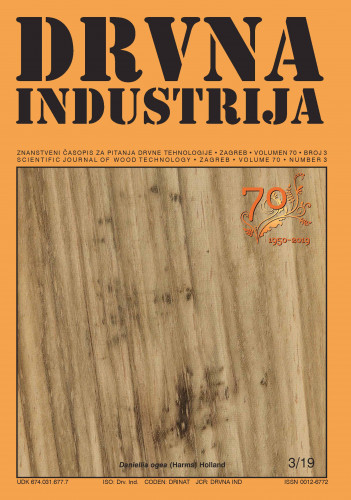The paper examines the trade competitiveness of the wood industry as a whole and some of its parts (Cork and wood, Cork and wood manufactures and Furniture and parts) of fi ve countries of South Eastern Europe (Serbia, Croatia, Bulgaria, Romania and Bosnia & Herzegovina) by using six indicators (Revealed Comparative Advantage – RCA, Index of Trade Performance – RCA2, Competitiveness Growth Index – RCA1, Michaely Index – MI, Index of Contribution to the Trade Balance – CTB and Grubel-Lloyd Index – GLI) in the period 2000-2015. On the basis of the results obtained, it was concluded that the wood industry of these countries observed as a whole has great export potential and that it significantly participates in their processing industry. The results of the survey show that companies from the wood industry viewed as a whole are competitive on the domestic market. However, this cannot be said of the international competitiveness of the timber industry of these countries. To be specific, the production of cork and wood from Bulgaria and Serbia, cork and wood manufactures excluding furniture from Bulgaria, Serbia and Croatia, as well as furniture and parts manufacturers from Bulgaria do not have a competitive advantage in the international market. By combining the values of six competitiveness indicators, it can be concluded that there is a statistically significant difference in the competitiveness of the wood industry of the countries observed. It can also be concluded that the degree of wood processing has a positive impact on their export competitiveness, this impact not being statistically significant, and that the level of finalization of production did not have a positive impact on the competitiveness of the wood industry of the selected countries of Southeastern Europe.; U radu se istražuje trgovinska konkurentnost drvne industrije pet zemalja jugoistočne Europe (Srbije, Hrvatske, Bugarske, Rumunjske te Bosne i Hercegovine), i to u cjelini i po dijelovima (pluto i drvo, proizvodi od pluta i drva, namještaj i dijelovi za namještaj). Istraživanje je provedeno u razdoblju od 2000. do 2015. uz pomoć šest pokazatelja konkurentnosti (utvrđene komparativne prednosti – RCA, indeksa neto poslovanja – RCA2, indeksa rasta konkurentnosti – RCA1, Michaely indeksa – MI, indeksa doprinosa trgovinskoj bilanci – CTB i Grubel-Lloyd indeksa – GLI). Iz dobivenih je rezultata zaključeno da drvna industrija navedenih zemalja, promatrana u cjelini, ima velik izvozni potencijal i da značajno sudjeluje u njihovoj prerađivačkoj industriji. Rezultati istraživanja pokazuju da su poduzeća iz sektora drvne industrije, promatrana u cjelini, konkurentna na domaćem tržištu. Međutim, to se ne može reći i za međunarodnu konkurentnost drvne industrije tih zemalja. Konkretno, proizvodnja pluta i drva iz Bugarske i Srbije, proizvodi od pluta i drva iz Bugarske, Srbije i Hrvatske, kao i namještaj i dijelovi za namještaj iz Bugarske nemaju konkurentsku prednost na međunarodnom tržištu. Kombiniranjem vrijednosti šest pokazatelja konkurentnosti utvrđena je statistički značajna razlika u konkurentnosti drvne industrije promatranih zemalja. Također se može zaključiti da stupanj obrade drva ima pozitivan utjecaj na njihovu izvoznu konkurentnost, ali taj utjecaj ipak nije statistički značajan. Nadalje, uočeno je da stupanj finalizacije proizvodnje nije pozitivno utjecao na konkurentnost drvne industrije promatranih zemalja jugoistočne Europe.
Sažetak

 Drvna industrija : znanstveni časopis za pitanja drvne tehnologije : 70,3(2019) / glavni i odgovorni urednik Ružica Beljo-Lučić.
Drvna industrija : znanstveni časopis za pitanja drvne tehnologije : 70,3(2019) / glavni i odgovorni urednik Ružica Beljo-Lučić.